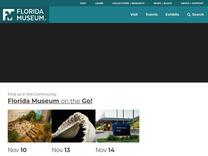Alligator Fossils at Montbrook – Research News https://www.floridamuseum.ufl.edu/science/alligator-fossils-at-montbrook/
Jonathan Bloch, a paleontologist at the Florida Museum of Natural History, discusses fossils of alligators and other animals found at the Montbrook dig site near Williston, Florida. His team compares the prehistoric alligator fossils to the bones of today’s alligators through digital modeling and sh
Research at the University of Florida by Olivia Stultz • June 7, 2019 A 5.5-million-year-old

